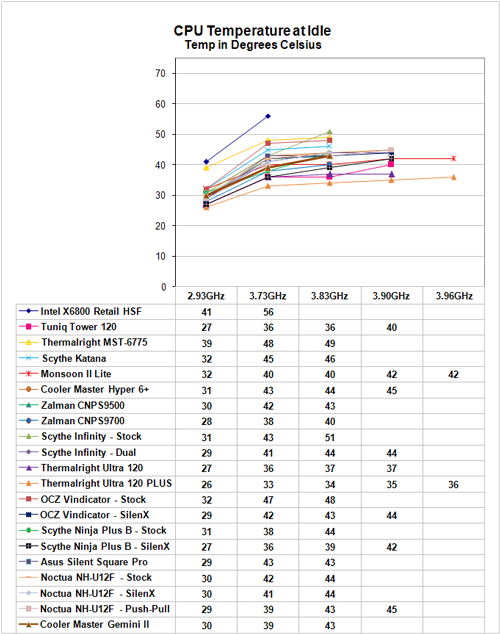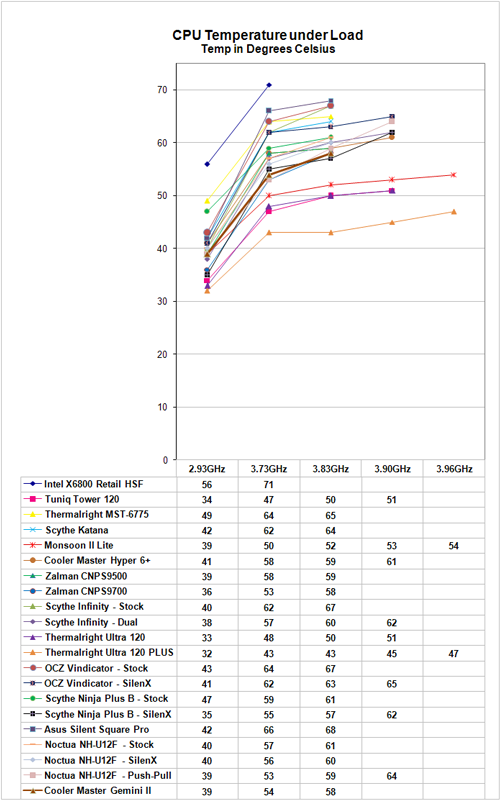Cooler Master GeminII: Performer or Poser?
by Wesley Fink on April 30, 2007 2:00 AM EST- Posted in
- Cases/Cooling/PSUs
Scaling of Cooling Performance
While the noise levels varied widely among the four fan configurations tested with the Cooler Master GeminII, the actual cooling performance was very similar across all fan configurations. For that reason, scaling performance will only be charted with the Noctua dual fan configuration, which exhibited the lowest noise with cooling efficiency comparable to the high-output fan configurations. The lower the line for a cooler (representing lower temperatures) the more efficient that cooler is at cooling.
At 2.93GHz the retail HSF is running at 41C, compared to 30C with a typical GeminII dual-fan configuration. This is not the best performance seen in our tests at idle, but it is competitive with the top coolers tested so far. This is a delta of 11C. The delta becomes greater as the overclock increases. At 3.73GHz the idle with the retail fan is 56C compared to the Gemini II at 39C - a delta of 17C. The cooling performance of the Gemini II is much better than the Intel retail cooler at idle, but the Gemini II does not reach the same cooling levels seen in the Thermalright coolers or the Tuniq 120.
Cooling efficiency of the GeminII under load conditions was compared to the retail HSF and other recently tested CPU coolers. Load testing can be very revealing of a cooler's efficiency. A basically flat line, particularly from 3.73GHz upward, indicates the cooler is still in its best cooling range. A line that is increasing rapidly indicates a cooler nearing the end of its ability to cool efficiently. Lines which parallel the best coolers over a range of values indicate similar efficiency slopes.
The GeminII is very efficient in cooling in the 2.93GHz to 3.73GHz overclock range. It continues on to a highest overclock of only 3.83GHz, which is well short of the 3.90GHz to 3.94GHz most of the top coolers in our testing have achieved. However, the sharp slope of the line from 3.73GHz to 3.83GHz indicates the GeminII is rapidly losing its ability to cool effectively at these higher overclocks. This is surprising, considerably the huge size of the GeminII combined with dual fans. Basically the Gemini II is performing no better than some of the $20 to $30 coolers we have tested.
Compare the GeminII, for example, to the lines for the Thermalright Ultra 120 Extreme and the Monsoon II Lite hybrid air/TEC cooler. Both these coolers have very flat stress performance lines as the overclock rises above 3.73GHz, which suggests they are still efficiently cooling and the CPU has run out of overclock headroom rather than the cooler reaching the limit of what it can effectively cool.
As stated many times, the overclocking abilities of the CPU will vary at the top, depending on the CPU. This particular CPU does higher FSB speeds than any X6800 we have tested, but the 3.9GHz top speed with the top tier heatpipe towers is pretty average among the X6800 processors we have tested with Tuniq cooling. A few of the other processors tested with the best air coolers reach just over 4 GHz, but the range has been 3.8 to 4.0GHz. Stock cooling generally tops out 200 to 400 MHz lower, depending on the CPU, on the processors tested in our lab. The 3.83 GHz with the Gemini II is average at best; we would expect a premium-priced CPU cooler to perform better.
While the noise levels varied widely among the four fan configurations tested with the Cooler Master GeminII, the actual cooling performance was very similar across all fan configurations. For that reason, scaling performance will only be charted with the Noctua dual fan configuration, which exhibited the lowest noise with cooling efficiency comparable to the high-output fan configurations. The lower the line for a cooler (representing lower temperatures) the more efficient that cooler is at cooling.
 |
| Click to enlarge |
At 2.93GHz the retail HSF is running at 41C, compared to 30C with a typical GeminII dual-fan configuration. This is not the best performance seen in our tests at idle, but it is competitive with the top coolers tested so far. This is a delta of 11C. The delta becomes greater as the overclock increases. At 3.73GHz the idle with the retail fan is 56C compared to the Gemini II at 39C - a delta of 17C. The cooling performance of the Gemini II is much better than the Intel retail cooler at idle, but the Gemini II does not reach the same cooling levels seen in the Thermalright coolers or the Tuniq 120.
Cooling efficiency of the GeminII under load conditions was compared to the retail HSF and other recently tested CPU coolers. Load testing can be very revealing of a cooler's efficiency. A basically flat line, particularly from 3.73GHz upward, indicates the cooler is still in its best cooling range. A line that is increasing rapidly indicates a cooler nearing the end of its ability to cool efficiently. Lines which parallel the best coolers over a range of values indicate similar efficiency slopes.
 |
| Click to enlarge |
The GeminII is very efficient in cooling in the 2.93GHz to 3.73GHz overclock range. It continues on to a highest overclock of only 3.83GHz, which is well short of the 3.90GHz to 3.94GHz most of the top coolers in our testing have achieved. However, the sharp slope of the line from 3.73GHz to 3.83GHz indicates the GeminII is rapidly losing its ability to cool effectively at these higher overclocks. This is surprising, considerably the huge size of the GeminII combined with dual fans. Basically the Gemini II is performing no better than some of the $20 to $30 coolers we have tested.
Compare the GeminII, for example, to the lines for the Thermalright Ultra 120 Extreme and the Monsoon II Lite hybrid air/TEC cooler. Both these coolers have very flat stress performance lines as the overclock rises above 3.73GHz, which suggests they are still efficiently cooling and the CPU has run out of overclock headroom rather than the cooler reaching the limit of what it can effectively cool.
As stated many times, the overclocking abilities of the CPU will vary at the top, depending on the CPU. This particular CPU does higher FSB speeds than any X6800 we have tested, but the 3.9GHz top speed with the top tier heatpipe towers is pretty average among the X6800 processors we have tested with Tuniq cooling. A few of the other processors tested with the best air coolers reach just over 4 GHz, but the range has been 3.8 to 4.0GHz. Stock cooling generally tops out 200 to 400 MHz lower, depending on the CPU, on the processors tested in our lab. The 3.83 GHz with the Gemini II is average at best; we would expect a premium-priced CPU cooler to perform better.










44 Comments
View All Comments
acejj26 - Monday, April 30, 2007 - link
Page 4...MHz, not GHzAnnihilatorX - Monday, April 30, 2007 - link
I have a feeling that the size of CPU coolers is directionaly proportional to the trend of global warmingDon't take this too seriously
Though the CPU TDPs are relatively constant at ~110W for high end CPUs, the coolers have been more and more elaborate.
Wesley Fink - Monday, April 30, 2007 - link
While TDP (Thermal Design Power or Thermal Design Point)has not varied a great deal recently, the wattage demands of a CPU in overclocking are MUCH higher than at stock speed, and they increase as the overclocking goes up as it dramaticlly does with the current Core 2 Duo processors. The more elaborate cooler designs are to effectively cool in the highest possible overclocking configuration OR to more efficiently cool with less air volume (noise reduction).We evaluate coolers using both these criteria - overclocking and relative noise.
Were we to evaluate coolers on just how well they cooled at rated CPU speed - which we do include in our reviews as "Stock Speed Performance" - our results table would likely look different and our recommendations would also be different.
pannivas - Monday, April 30, 2007 - link
Maybe I haven’t searched hard enough, but until now this cooler is the only cooler that can fit my Zalman HD135 HTPC case 130mm(H) and perform good as well as silently.stromgald - Monday, April 30, 2007 - link
The Thermalright XP-120 is also a good option for low-profile cases. I saw a review where it performed better than the Thermalright MST-6775, which is in this review, so I think it should be in the ball park of the Gemini II. It's also probably cheaper since it's smaller, and quieter since it only uses one 120mm fan.yacoub - Monday, April 30, 2007 - link
So basically if you're someone who is looking for a cooler that's average amongst the top aftermarket coolers in prowess, offers a lower height that should fit in just about any case, can mount twin 120mm fans, is practically silent in operation with the right fans, and directs airflow down over the board removing the need for an additional fan to do the that, it could be seen as a good product worth using?Wesley Fink - Monday, April 30, 2007 - link
If you need a shorter cooler this could be a good choice. It can definitely be "silent" with the right fan(s). It does cool much better than the Intel retail fan.thechucklesstart - Monday, April 30, 2007 - link
If you set up the fans in a pull configuration if it would increase cooling?Most vehicles have a pulling fan on their radiator because it is more efficient than a pushing fan and this situation seems similar.
Wesley Fink - Monday, April 30, 2007 - link
All Cooler Master diagrams and specifications show the fans mounted to blow air down toward the motherboard and components. We tested the fans mounted as Cooler Master specified. The fan wounting direction could be reversed if that is what you choose.BladeVenom - Monday, April 30, 2007 - link
I think it's would be worth testing. He's not the only one wondering if it might be better that way.